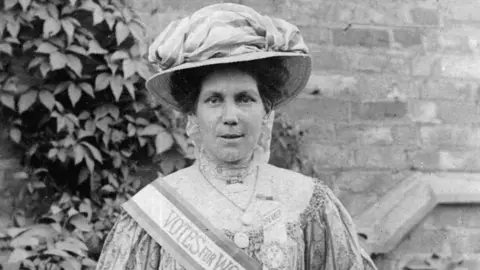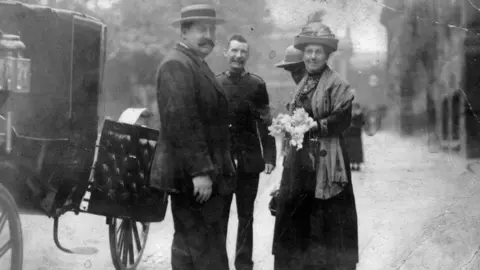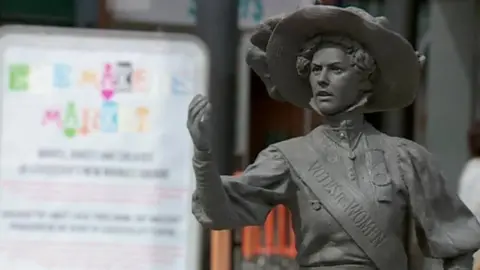Leicester suffragette Alice Hawkins made of 'true grit'
 Hawkins family
Hawkins familyA statue is to be unveiled this weekend in Leicester to Alice Hawkins, a leading light of the suffragette movement who was jailed five times during her struggle to achieve equality. BBC News takes a look at her remarkable life.
"You must use your vote; we suffered for it." This is the lasting memory the family of Hawkins have of her saying to them.
Born into a working-class family in Stafford in 1863, she left school at the age of 13 and by her early 20s was working as a machinist at the Equity Shoe factory in Leicester.
She soon realised that working conditions and pay for women were inferior compared to those of her male colleagues and began campaigning for equality.
Great-grandson Peter Barrett said: "She was a shoe machinist working long hours but a very determined woman.
"She wanted equal pay for the women working in the shoe factories in Leicester."
Charged by mounted police
Hawkins became disillusioned with the trade union movement, as she felt its main focus was to improve conditions for men, and instead turned to the Women's Social and Political Union (WSPU).
After attending her first meeting of the WSPU in February 1907, followed by a march to the House of Commons, Hawkins was jailed for the first time.
She was one of several women charged down by mounted police and sent to Holloway prison.
 From family of Alice Hawkins
From family of Alice Hawkins This first stint in jail had a profound affect on Hawkins, her family recalled, and the following month she invited Sylvia Pankhurst to speak in Leicester.
The Leicester branch of the WSPU was formed shortly after and Hawkins began a "tireless campaign" of speaking at village greens and outside factory gates to get women from all walks of life to join the suffragette cause.
However, not everyone was sympathetic, Mr Barratt said, and campaigners were "frequently heckled, harangued and physically assaulted".
Pauper's grave
But they had their sights fixed on the future.
"Alice saw that through the vote, women would become empowered in society of the day," he said.
And that day finally came with the passing of the 1918 Representation of the People Act, giving the vote to the first women - although not all women - in Britain.
Hawkins, like many other "rank-and-file" suffragettes, went back to a normal life not quite realising what a difference they made to society, Mr Barratt said.
So perhaps she would be surprised that on Sunday, a statue in her memory will be unveiled in Leicester's Market Square.
 Leicester City Council
Leicester City CouncilFittingly, Emmeline Pankhurst's great-granddaughter, Dr Helen Pankhurst, is due to attend the event.
"I think it will really add to the occasion to have Helen there as her great-grandmother, grandmother and sisters gave so much support to Alice," Mr Barratt said.
Hawkins died in 1946, aged 83, and was buried in a pauper's grave.
Her family have worked hard to honour her memory and remember a woman of determination and courage.
"My mum would say Granny Alice would never back down in a family argument - she was made of true grit," Mr Barratt said.
